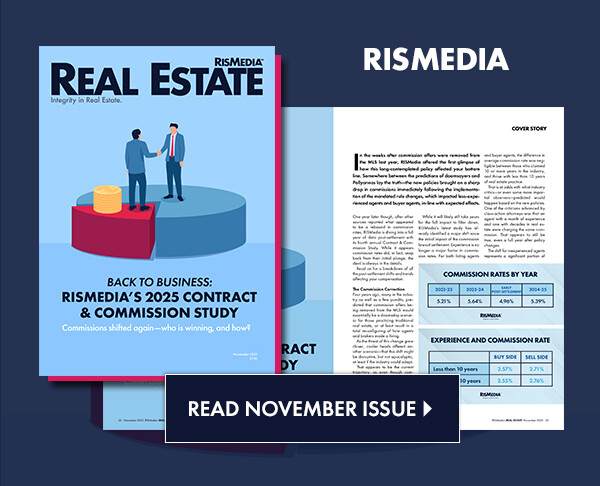Housing markets across the U.S. are finally seeing more inventory up for grabs, alleviating a supply crunch that’s been years in the making. Homes for sale jumped 32% year-over-year in May, according to the Intercontinental Exchange (ICE) July Mortgage Monitor Report released Monday.
The supply deficit compared to pre-pandemic levels shrank to just 13% compared to 34% this time a year ago, ICE found. At this pace, the market could return to normal inventory levels by fall, which is good news for potential buyers who’ve been lingering on the sidelines.
“We’re on pace to see the number of homes available for sale normalized by the time we get to Halloween this year,” Andy Walden, head of mortgage and housing market research at ICE, told RISMedia in an interview Monday.
Denver leads the pack with twice the inventory of pre-pandemic levels, while markets like Washington, D.C., Las Vegas and San Diego have seen inventory growth exceed 60% over the past year. Thirty-nine of the top 100 markets have returned to normal inventory levels.
The picture isn’t as promising in the Northeast and Midwest where there are deep inventory deficits, Walden noted.
Despite more homes on the market overall, new listings are still 19% below historical levels, suggesting many homeowners are still reluctant to sell.
So what’s giving them cold feet? According to ICE’s Home Price Index, annual home price appreciation fell to 1.3% in early June, with 30% of the largest markets seeing prices soften by at least a full percentage point from their peaks. That means sellers are walking away with lower net profits, so some might opt not to sell until prices rebound a bit, Walden explained.
Borrowers grappling with affordability strain
Faced with mortgage rates in the high 6% range and stretched budgets, buyers are getting creative with some loan options. More than 8% of borrowers are now using either adjustable-rate mortgages (ARMs) or temporary rate buydowns to make purchases work, ICE research found.
Another reason for concern: Average debt-to-income ratios reached 40% in May as loan amounts topped $375,000 and loan-to-value ratios exceeded 85%, showing that borrowers are maxed out on borrowing power.
When it comes to home prices, buyers in some markets are finally seeing some relief as 31 of the nation’s 100 major markets saw prices drop 1% in early June from recent highs. The correction is spreading from the Sunbelt into Western markets, suggesting a broader cooling trend—especially in California where seven of the state’s nine largest markets posted annual price declines, according to ICE.
Meanwhile, the Midwest and Northeast continue seeing modest growth, with Rochester, New York, leading at 7.6% annual appreciation, followed by Hartford, Connecticut, at 6.9%.
Negative equity, student debt presents future risks
While overall negative equity rates remain low at 1%, the concentration among recent buyers tells a different story. In Cape Coral, Florida, more than one in four borrowers who took mortgages in 2023 or 2024 are now underwater, or owe more on their mortgage than what their home is now worth. In Austin, 18% of 2022 vintage loans are in negative equity territory.
FHA and VA loans show the highest vulnerability, with nearly 5% of VA mortgages and 2.6% of FHA loans currently underwater, ICE reported.
Another potential risk: Nearly 30% of FHA borrowers carry student loan debt. The Department of Education just resumed collections on defaulted loans after a five-year pause.
Serious student loan delinquencies more than doubled from 15% in January to over 30% by March, which is especially concerning since ICE’s data shows borrowers with student debt are four times more likely to default on their mortgages compared to those current on student payments.
In the latter half of the year, Walden emphasized that mortgage lenders and government agencies will need to have clear policies around how they deal with folks who are past due on their mortgages and what options are available to them. This is critical as pandemic-era provisions designed to help struggling borrowers begin sunsetting for good.












